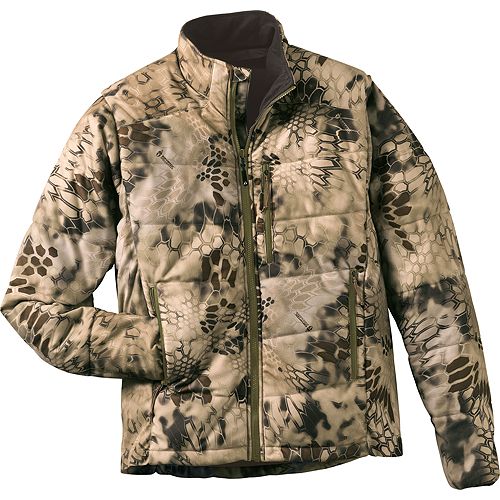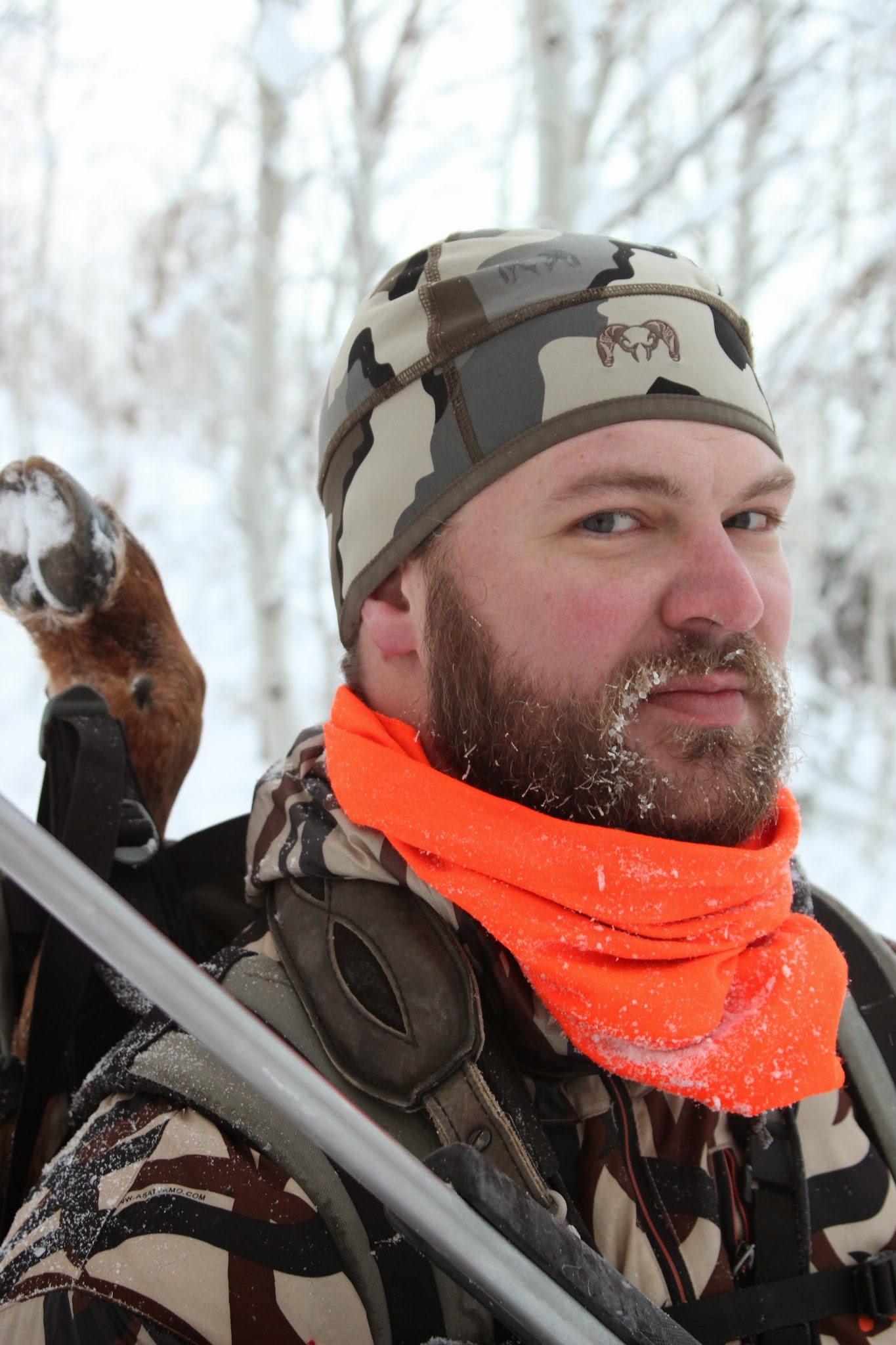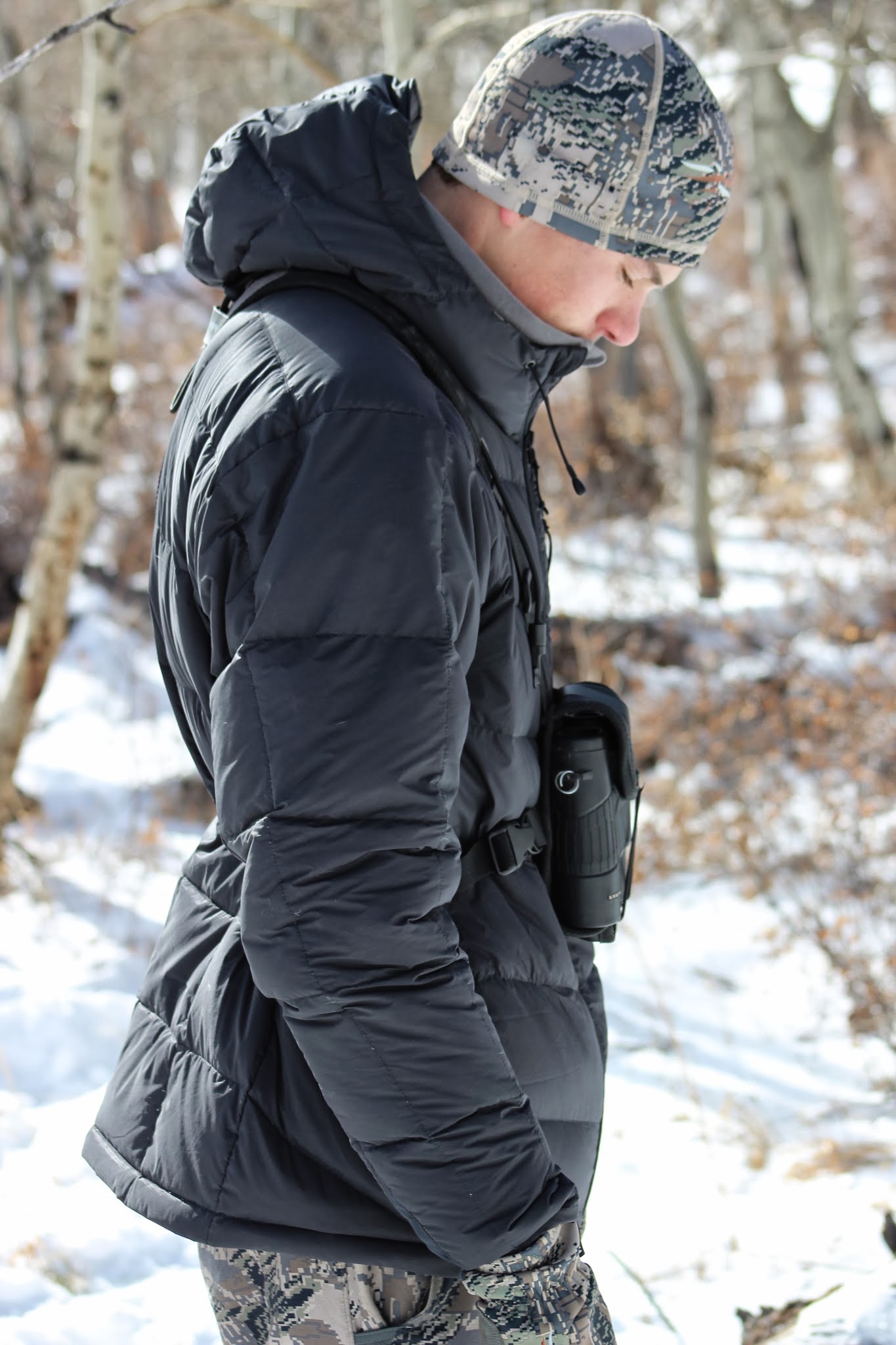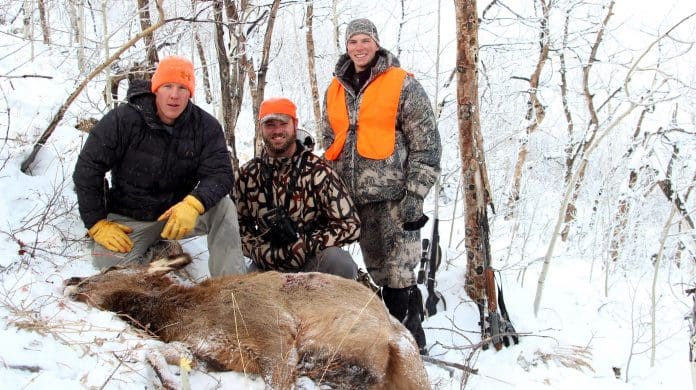Puffy Jackets: Choosing the Best Insulating Layer for You
by Scott Reekers
From the highest peak in the mountain range I was looking down on two small, single-engine airplanes flying close to the basin walls as I glassed for mule deer. The guys in the planes had it easy! They didn’t have to endure the exhausting hike up the mountain, nor did they have to deal with the chill brought on by the cool temperatures and piercing breeze as it wicked sweat from my skin. On the other hand, I was dealing first hand with the challenge of keeping my body warm in the thin mountain air. I was prepared though as I put on a favorite piece of gear amongst backcountry aficionados, the “puffy” jacket.
If you’re in the market for a puffy jacket you might be wondering which one is right for you? Which jacket best matches the environment you hunt? What is the right insulation type? How much insulation should be in the jacket for the conditions you’ll be facing? Can you climb 500 feet to the next glassing location, or will you sweat like crazy in this jacket?
Many of the top jackets can’t be found in local stores, so those pertinent questions can be difficult to answer. Adding to the angst of the decision is the price tag many of these jackets carry. Buying the right one on the first try is important! This review will help sort through some of the top hunting puffy jackets so you can better decide which one is best for your application.
Kryptek Kratos

Insulation: Primaloft One
Pockets: 3 external, 1 internal breast pocket
Hood: None
Stuff Sack: Yes, external cinch stuff sack.
Ideal Temperatures: 10 to 20 degrees in high activity, 20 to 40 degrees in moderate and low activity.
Shell Type: Polyester
Price: $179.00
Kryptek is a young company built from experience on the battlefield. Nothing puts gear and clothing to the test better than a soldier, which translates into high quality hunting clothing for the backcountry hunter.
The Kratos is a lightweight puffy jacket with an athletic cut. Freedom of movement for activities like shooting a rifle or bow are integrated into the jacket with two stretch panels that run up the sides terminating at the armpit. The Primaloft One insulation isn’t sewn into the stretch panels which also helps the jacket breathe in the high sweat areas of the body.
The Kratos performs well in the early season hunts when temperatures don’t plunge far below the 20 degree mark. When partnered with a rain jacket such as the Koldo or soft shell like the Cadog the comfort range can be extended lower.
When overall pack weight and bulk needs to be kept to a minimum, the Kratos will be in its element. It stuffs down small into its stuff sack and fits inside the nooks and crannies of your pack, making it a great choice for lightweight expeditions.
Our Favorite Features: The stretch panels provide great range of motion. Glassing often requires twisting and looking over ledges at funny angles to find an animal’s hiding spot. The stretch panels make the awkward positions more comfortable by preventing tension in the back and shoulders where other jackets tend to limit mobility.
The outer shell material probed durable when we abused it repeatedly pulling a heavy pack off and on and moving through the trees and brush. The DWR on the polyester shell works well in wet snow, or a light rain, even though it is not water-proof. Of all the jackets, the Kratos outer shell broke the wind the best when standing or hiking. When partnered with a rain jacket the layering system was great for even the windiest days glassing.
Zipper management was great with the Kratos; they could be handled with gloves without any hassle. Opening and closing the jacket or its pockets requires minimal movement, which is an important consideration while stalking an animal.
Our Least Favorite Features: The jacket does not have a drawstring around the waist, making it tough to stop breezes from coming up the back when seated.
You Should Take This Jacket Home If: You are an early season hunter who spends a lot of time from August to Early October hunting the high country. This jacket will excel in conditions like Montana and Colorado’s archery seasons, and Wyoming’s mid-September rifle mule deer hunts.
The jacket is also great for hunters who sweat a lot. The Primaloft one insulation dries quickly and continues to holds heat even when damp. For the slow moving mule deer stalk after climbing 500 feet to get in position, the insulation will function perfectly.
Leave This Jacket On the Rack If: You will be encountering extremely cold temperatures or won’t be active. The jacket will work in the cold temperatures when partnered with an outer shell, but for stand-alone use in the late seasons pick up one of the heavier options.
If you are set on buying Kryptek insulation they are releasing a down jacket for 2014 that will potentially perform better in the late seasons based strictly on its product description. It’s an 800 fill treated down that should perform well in lower temperatures.
First Lite Uncompahgre
Insulation: 100 gram Cocona fill in the body, 60 gram Cocona fill in arms and hood
Pockets: 2 pockets on the front
Hood: Pull string adjustment on the front, fleece lined around the face and ears.
Stuff Sack: Integrated into the left side pocket
Shell Type: 100% Polyester with a DWR coating.
Ideal Temperatures: 0 to 20 degrees in mid to high activity, 20 to 40 degrees in moderate and low activity.
Weight:
Price: $200.00-225.00 (Color dependent)
First Lite is best known for their quality Merino wool offerings, but recently entered the outer-wear market with a full line of products for any and all situations. The Uncompahgre jacket is a well thought out insulating garment that can handle most cold weather situations.
The Uncompahgre is built around the Cocona active particle technology which transports moisture from inside the jacket out, while retaining warmth. The body fill is 100 gram Cocona while the hood and arms are 60 gram for less of a bulky feel. The shoulder cut is wide and fits over the top of most base layers with ease.
The exterior shell noticeably cuts the wind and the DWR worked as advertised in rain and sleet. The jacket won’t replace rain gear, but can easily resist an afternoon storm that might force other puffy jackets back into the pack.
The jacket incorporates stretch panels into the armpits, shoulders, and wrists allowing effective movement for tasks like breaking down an animal for the pack out. The shoulder stretch panels enable full range of motion, while the stretch panels on the wrist are comfortable and easily fit inside the cuffs of most gloves. The wrists cuffs stay tight around the wrists and prevent snow or debris from making it inside the jacket.
The Uncompahgre retains fit and function when worn under a pack. It doesn’t bunch up on the back or shoulders and provides a comfortable fit when it’s necessary to have insulation on a pack out. The cow elk hunt shown in the accompanying photos were in temperatures hovering just above zero degrees, not counting wind chill. The Uncompahgre made the pack out comfortable in spite of the unforgiving conditions.

The hood cinches down with two draw-strings on the front, and one on the back to snugs it around the head. Fleece panels inside the hood cover the ears adding warmth and comfort.
Our Favorite Features: It’s easy to misplace small items like stuff sacks on a backpack hunt. To lose the stuff sack on the Uncompahgre a hunter would have to lose the whole jacket. The sack is integrated into the left side pocket, simply pull the pocket out and stuff the jacket inside.
The Uncompahgre was very quiet while moving through brush, and even when abused in the willows it didn’t snag. The jacket’s shell is water resistant, and the “garages” on the tops of all of the zippers help keep water out. If you get caught in a fall rain storm this jacket will hold its own.
Our Least Favorite Features: The zippers can be hard to use. They are water-proof, but tend to be tough to move up and down. They are also a little noisy, but honestly, that’s a minor nitpick.
The hood cinches down nicely, but the cinch strings can be difficult to release. This is again more of a minor nuisance than it is a knock on the jacket’s performance.
You Should Take This Jacket Home If: You want a do-all jacket that will work in a variety of hunting environments. This jacket performs well in low level activities like glassing, all the way up to high level activity like a packing meat in single digit temperatures.
Leave This Jacket On the Rack If: You are looking for a jacket that will function primarily as a second or third layer. The Uncompahgre functions best as an outer layer and the loose fit is part of the package.
KUIU Super Down Hooded Jacket

Insulation: Toray treated “Quix Down”
Pockets: 3 outer pockets, two lower front, one on chest.
Hood: 3 cinch points
Stuff Sack: Breast pocket
Shell Type: 20 Denier Toray Stretch Nylon
Ideal Temperatures: Single digit temperatures with high activity levels, Low and Moderate activity levels up to 40 degrees.
Weight: 11 oz
Price: $249.00
KUIU is built around a consumer direct business model founded on high quality products that are not available in retail stores. By circumventing the “middle-man” they are able to offer top-tier products at reasonable prices price. With this concept in mind, the Super Down hooded jacket came to be.
The heart of the jacket is the Toray Quix Down sewn into square baffles on the front, and tubular baffles on back. The sewing pattern prevents the down from migrating to places that won’t keep the user warm. The down is treated with a DWR that repels water and keeps the down lofted even when wet. For anyone that hunts in areas with lots of precipitation, this is a big advantage over traditional down-filled jackets.
The Super Down’s athletic cut fits snugly around the body providing a comfortable range of motion in the shoulders. The jacket works well with a long sleeved base layer and a mid-layer in extreme cold. As a third outer layer the jacket performs well and fits well under Kuiu’s soft shell Guide Jacket when a little more insulation is needed. The slim arm cuffs work well inside the soft shell and make for a very comfortable system, even in the coldest temperatures.
With a long sleeved base layer under the jacket, we stayed comfortable in temperatures of -5 to 15 degrees while active. I used the jacket as an outer layer instead of a mid-layer. Bulky base layers can compromise mobility due to the athletic fit, so you may want to consider up-sizing if you plan to use a couple base layers and a mid-weight fleece under the Super Down. The jacket also deflected the wind effectively.
The Super Down has drawstrings inside each front pocket to cinch the waist. The hood has draw-strings to tighten around the face and a Velcro strap on the back of the head to adjust for a clear field of view.
The breast pocket acts as a stuff sack, and it packs down very small. Some jackets take up way too much space for minimalist trips, but adding a Super Down to your pack is so convenient you’ll rarely be tempted to leave it behind.
The Super Down jacket washes well, and had no blood stains after a successful elk hunt. The Quix down also dries much faster in a conventional dryer than untreated down making overall care easy.
Our Favorite Features: The jacket’s athletic fit is a strong point as well as the sleek feel which made it very comfortable to move in, especially in the shoulders. A puffy jacket can sometimes make the person wearing it feel like a walking marshmallow, this is not the case with the Super Down Jacket. It is very easy to pull a pack over the shoulders and movement is natural and unimpeded.
The integrated stuff sack in the chest pocket is great for small pieces of gear like a gps or two way radio. Pocket size may seem like a non-factor but a pocket that is too big will interfere with straps on a pack. The SD’s pocket size is an asset for hauling the small pieces of gear that a hunter needs quick access to.
Our Least Favorite Features: Wrist wraps, or stretch material to keep snow and debris out of the fore-arms would be a nice addition. While field dressing an elk in 8-10 inches of snow it was easier for ice and snow to end up inside the jacket arms than it was in the other jackets. When partnered with rain gear or a soft shell jacket that has these features this would be a non-issue, but in the snowy conditions we tested it wrist wraps would have been appreciated.
Take This Jacket Home If: You want a jacket that performs very well as a mid-layer in mild to cold temperatures, and an outer layer in some of the warmer early seasons. It will also perform well in really cold temperatures if you need to wear it to keep warm on a stalk.
The jacket will also shine on hunts like North Dakota’s November Mule Deer archery season or a Colorado’s 3rd and 4th seasons. The jacket’s athletic cut makes drawing a bow easy, and we never worried about hitting the sleeves on release. Late season hunts often require a lot of movement and the Super Down will be in its element on a hunt in those conditions. For an archer, this jacket makes sense!
Leave This Jacket on the Rack: If you hunt brushy types of areas where anything and everything can rub on the jacket. The jacket’s shell was noisier in these conditions than the other jackets in the review.
Sitka Kelvin Down Hoody
Insulation: 800 fill European Goose Down
Pockets: 2 external zippers, one mesh internal
Hood: 3 cinch points, 2 on front, one on back.
Stuff Sack: Water Resistant material, draw string top.
Shell Type: Nylon, DWR treated
Ideal Temperatures: -10 to mid-30’s (we did not test below -10 in the field). Use in temps above 30 suitable with minimal activity, such as long glassing sessions in harsh wind.
Price: $369.00
The Kelvin down hoody from Sitka is advertised as a sleeping bag for your upper body. It is exactly that. The 800 fill down provides plenty of insulation for late season hunts where temperatures rarely rise above the freezing point. On cold morning glassing sessions it can be difficult to stay put when looking for a rutting buck, or a solitary trophy bull in the high country. In states where hunts are offered in November and December this jacket will meet its full potential.
The Nylon outer shell, offered in Optifade Open Country or lead (grey) color options, cuts wind chill well and keeps the user warm in cold breezes. The jacket is designed to be used as an outer layer over the top of all other layers, wind resistance is even better when partnered with a soft shell jacket underneath.
A DWR coating keeps light rain and sleet from wetting out the shell and insulation. The DWR is not designed to sit out a major storm, so be warned that it would be wise to put the Kelvin away or cram rain gear over it during heavier precipitation.
The down in the Hoody is not treated with a water repellant, so it’s necessary to plan for ample drying time if you get it wet. To prevent unnecessary exposure to water Sitka provides a stuff sack that keeps water off of the down while it is inside your pack. To test the stuff sack’s water resistance we stuffed the jacket inside and ran it under water from the kitchen sink. Sitka does not claim that the stuff sack is water-proof, but we wanted to test it anyway. Much to our surprise water never made its way inside and the jacket lofted exactly the way it should when we pulled it out of the sack. The stuff sack will still leak through the top if submerged, but on the inside of a pack that is beginning to wet out in the rain it provides ample protection.
The hood is easily cinched down around the head with three drawstrings. Two are located on the front, and one on the very back, allowing the user to pull the hood snugly around the face for a cozy fit in the coldest environments.
Our Favorite Features: The front pockets of this jacket have insulation on both sides, which keeps your hands very warm when inside. The design also makes sure that drafts won’t penetrate to your body through the pockets.
The jacket is designed to go over the top of all of the layers a hunter is already wearing. This means just throwing it on rather than taking off the soft shell, putting on the insulation layer, and then putting the soft shell back on over the top and losing precious body heat in the process. This is a well thought out feature for a jacket designed for the coldest hunts.
Our Least Favorite Features: The down is not treated and by nature, it takes more time to dry than comparable synthetics or treated down. If this jacket got wet during a hunt it could make for a cold outing and a long wait waiting for the jacket to dry and regain its loft. In a heated tipi style shelter, loft would be brought back faster, but bear in mind that it took nearly an hour and a half in a conventional dryer on medium heat in the comfort of home to dry the jacket after washing. Even in a heated shelter the wait time would be significant.
We also would like to see the sleeves have less fill to reduce the bulky feel of the jacket. The jacket would be more comfortable allowing better clearance for archers and better range of motion in the shoulders and arms.
You should take this jacket home if: You get cold easily and constantly worry about whether you should add another layer to your clothing system. This jacket is warm enough to take the place of two layers if needed. Cold blooded people will be very satisfied with this piece.
The Kelvin down hoody will perform well during winter coyote or wolf calling sessions many hunters participate in after big game seasons are over. The Optifade Open Country pattern will work well in most late season environments, and the down insulation will be warm enough for the cold temperatures that predator hunting is known for.
This jacket is also great for the late season hunter who has to glass for animals in chilly winter conditions. The further North, or the lower your temperatures during hunting season the more likely this jacket would be a great choice. This jacket performed well in a December cow/calf hunt in Wyoming that dropped well below zero with wind chill.
Leave this jacket on the rack if: You are strictly a bowhunter who spends most of your time in the field during the early seasons before the snow and wind hit the high country. The down hoody will be too much insulation for your hunting style and the sleeves potentially could get caught on your bowstring if a shot opportunity came.
This jacket should not be the first choice for the hunter who practices an active style of big game hunting. In all but the coldest conditions the Kelvin is too warm for hiking. A puffy jacket with less insulation would be a better choice if you want a jacket you can actively hunt in.
For 2014 Sitka is releasing the Blizzard series which is a blend of Primaloft and 650 fill down insulation. The Blizzard jacket’s outer shell is water-proof combined with water resistant zippers making for a very nice addition to the Sitka line up.
Like anything else in the world of backcountry hunting, there’s more than meets the eye when it comes to picking the “perfect” piece of gear for the way you hunt! Picking the right puffy jacket for the job can lend confidence to your ability to handle hunts in terrible conditions. Gear that helps you hunt tough conditions can help you notch your tag and that’s why so many experienced hunters keep a puffy jacket as a staple in their gear list!

















